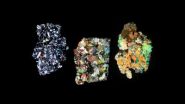(Press-News.org) A carbon nanotube sponge that can soak up oil in water with unparalleled efficiency has been developed with help from computational simulations performed at the Department of Energy's (DOE's) Oak Ridge National Laboratory.
Carbon nanotubes, which consist of atom-thick sheets of carbon rolled into cylinders, have captured scientific attention in recent decades because of their high strength, potential high conductivity and light weight. But producing nanotubes in bulk for specialized applications was often limited by difficulties in controlling the growth process as well as dispersing and sorting the produced nanotubes.
ORNL's Bobby Sumpter was part of a multi-institutional research team that set out to grow large clumps of nanotubes by selectively substituting boron atoms into the otherwise pure carbon lattice. Sumpter and Vincent Meunier, now of Rensselaer Polytechnic Institute, conducted simulations on supercomputers, including Jaguar at ORNL's Leadership Computing Facility, to understand how the addition of boron would affect the carbon nanotube structure.
"Any time you put a different atom inside the hexagonal carbon lattice, which is a chicken wire-like network, you disrupt that network because those atoms don't necessarily want to be part of the chicken wire structure," Sumpter said. "Boron has a different number of valence electrons, which results in curvature changes that trigger a different type of growth."
Simulations and lab experiments showed that the addition of boron atoms encouraged the formation of so-called "elbow" junctions that help the nanotubes grow into a 3-D network. The team's results are published in Nature Scientific Reports.
"Instead of a forest of straight tubes, you create an interconnected, woven sponge-like material," Sumpter said. "Because it is interconnected, it becomes three-dimensionally strong, instead of only one-dimensionally strong along the tube axis."
Further experiments showed the team's material, which is visible to the human eye, is extremely efficient at absorbing oil in contaminated seawater because it attracts oil and repels water.
"It loves carbon because it is primarily carbon," Sumpter said. "Depending on the density of oil to water content and the density of the sponge network, it will absorb up to 100 times its weight in oil."
The material's mechanical flexibility, magnetic properties, and strength lend it additional appeal as a potential technology to aid in oil spill cleanup, Sumpter says.
"You can reuse the material over and over again because it's so robust," he said.
"Burning it does not substantially decrease its ability to absorb oil, and squeezing it like a sponge doesn't damage it either."
The material's magnetic properties, caused by the team's use of an iron catalyst during the nanotube growth process, means it can be easily controlled or removed with a magnet in an oil cleanup scenario. This ability is an improvement over existing substances used in oil removal, which are often left behind after cleanup and can degrade the environment.
The experimental team has submitted a patent application on the technology through Rice University. The research is published as "Covalently bonded three-dimensional carbon nanotube solids via boron induced nanojunctions," and is available online here: http://www.nature.com/srep/2012/120413/srep00363/full/srep00363.html.
INFORMATION:
The research team included researchers from ORNL, Rice University; Universidade de Vigo, Spain; Rensselaer Polytechnic Institute; University of Illinois at Urbana-Champaign; Instituto de Microelectronica de Madrid, Spain; Air Force Office of Scientific Research Laboratory; Arizona State University; Universite Catholique de Louvain, Belgium; The Pennsylvania State University; and Shinshu University, Japan.
The work was supported by the National Science Foundation, the U.S. Air Force Office of Scientific Research, the U.S. Army Research Laboratory, and by the DOE Office of Science through ORNL's Center for Nanophase Materials Sciences (CNMS) and the laboratory's Leadership Computing Facility.
CNMS is one of the five DOE Nanoscale Science Research Centers supported by the DOE Office of Science, premier national user facilities for interdisciplinary research at the nanoscale. Together the NSRCs comprise a suite of complementary facilities that provide researchers with state-of-the-art capabilities to fabricate, process, characterize and model nanoscale materials, and constitute the largest infrastructure investment of the National Nanotechnology Initiative. The NSRCs are located at DOE's Argonne, Brookhaven, Lawrence Berkeley, Oak Ridge and Sandia and Los Alamos national laboratories. For more information about the DOE NSRCs, please visit http://science.energy.gov/bes/suf/user-facilities/nanoscale-science-research-centers/.
ORNL is managed by UT-Battelle for the Department of Energy's Office of Science. DOE's Office of Science is the single largest supporter of basic research in the physical sciences in the United States, and is working to address some of the most pressing challenges of our time. For more information, please visit http://science.energy.gov.
END
The report "Sequestration: Health Research at the Breaking Point," released today by Research!America, demonstrates the damaging consequences of potential automatic spending cuts, or sequestration, to the nation's medical research enterprise and public health, and offers examples on how these cuts would delay scientific discoveries that could lead to new treatments and cures for deadly diseases.
This report provides:
The estimated budget cuts to the National Institutes of Health, the Centers for Disease Control and Prevention, the Agency for Healthcare Research and ...
TEMPE, Ariz. – New findings from NASA's Dawn spacecraft lay the groundwork for the first geological overview of asteroid (4)Vesta and confirm the existence of not one but two giant impact basins in its southern hemisphere. The findings, published today in a set of Science papers, will help scientists better understand the early solar system and processes that occurred as it formed and evolved.
The Dawn spacecraft, orbiting asteroid Vesta since July 2011, has already acquired several thousand images of the asteroid's surface, revealing a complex landscape. The images ...
MAYWOOD, Ill. – Patients see potential benefits from direct-to-consumer genetic testing, but are also concerned about how test results will be used, and generally are unwilling to pay more than $10 or $20 for them, according to focus groups conducted by researchers at Loyola University Chicago Stritch School of Medicine.
Findings by first author Katherine Wasson, PhD, MPH, and colleagues are published in the American Journal of Bioethics Primary Research. Wasson, an assistant professor in Loyola's Neiswanger Institute for Bioethics and Health Policy, is an expert on the ...
Seaweeds are important foundational species that are vital both as food and habitat to many aquatic and terrestrial shore organisms. Yet seaweeds that cling to rocky shores are continually at risk of being broken or dislodged from their holds by crashing waves with large hydrodynamic forces. So how do such seaweeds survive in intertidal zones? Do they have special properties that make them extremely flexible or particularly strong?
Patrick Martone (University of British Columbia) has spent a considerable amount of time standing on the shore watching big waves crash ...
When UCLA's Christopher T. Russell looks at the images of the protoplanet Vesta produced by NASA's Dawn mission, he talks about beauty as much as he talks about science.
"Vesta looks like a little planet. It has a beautiful surface, much more varied and diverse than we expected," said Russell, a professor in UCLA's Department of Earth and Space Sciences and the Dawn mission's principal investigator. "We knew Vesta's surface had some variation in color, but we did not expect the diversity that we see or the clarity of the colors and textures, or their distinct boundaries. ...
PHILADELPHIA — When the Deepwater Horizon drilling rig exploded April 20, 2010, residents feared that their Gulf of Mexico shores would be inundated with oil. And while many wetland habitats and wildlife were oiled during the three-month leak, the environmental damage to coastal Louisiana was less than many expected, in part because much of the crude never made it to the coast.
Research by a trio of geoscientists, including the University of Pennsylvania's Douglas Jerolmack, now offers an explanation for why some of the oil stayed out at sea. Using publicly available ...
For the last few decades, space scientists have generally accepted that the bubble of gas and magnetic fields generated by the sun – known as the heliosphere – moves through space, creating three distinct boundary layers that culminate in an outermost bow shock. This shock is similar to the sonic boom created ahead of a supersonic jet. Earth itself certainly has one of these bow shocks on the sunward side of its magnetic environment, as do most other planets and many stars. A collection of new data from NASA's Interstellar Boundary Explorer (IBEX), however, now indicate ...
Forests in the Amazon Basin are expected to be less vulnerable to wildfires this year, according to the first forecast from a new fire severity model developed by university and NASA researchers.
Fire season across most of the Amazon rain forest typically begins in May, peaks in September and ends in January. The new model, which forecasts the fire season's severity from three to nine months in advance, calls for an average or below-average fire season this year within 10 regions spanning three countries: Bolivia, Brazil and Peru.
"Tests of the model suggested that ...
GALVESTON, Texas – April 30, 2012 – The proportion of insured girls and young women completing the human papillomavirus (HPV) vaccine among those who initiated the series has dropped significantly – as much as 63 percent – since the vaccine was approved in 2006, according to new research from the University of Texas Medical Branch (UTMB) in Galveston.
The study, published in the current issue of Cancer, reveals the steepest decline in vaccine completion among girls and young women aged nine to 18 – the age group that derives the greatest benefit from the vaccine, which ...
VIDEO:
Associate professor Michael Davies (Robinson Institute, University of Adelaide) discusses the findings of a study into the risk of major birth defects associated with assisted reproductive technologies.
Click here for more information.
A University of Adelaide study has identified the risk of major birth defects associated with different types of assisted reproductive technology.
In the most comprehensive study of its kind in the world, researchers from the University's ...



